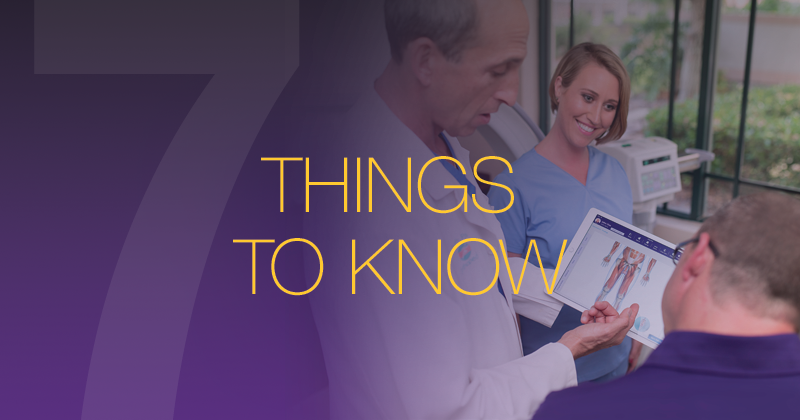7 Things to Know When Implementing an Orthopedic EHR

So what’s next after you select your orthopedic software system?
1. Work with your EHR vendor to create an implementation plan.
Your EHR vendor will help assess your workflow within your practice to understand how to use your new orthopedic EHR effectively. Your EHR vendor should help you identify the functionality and features important for your practice and provide users the needed education. Together you’ll set a feasible timeline for implementation tasks and set goals to monitor progress and measure success.
Identify implementation champions, which we like to call “superusers,” within the practice that will provide support and encouragement during the process. Depending on your practice size you may want to have both an implementation lead and a lead physician. Your implementation lead will serve as the main contact with the EHR vendor and monitor progress. A lead physician will have intimate experience with the clinical applications of your new EHR and can provide unique insight on exam workflow.
2. Get to know your EHR vendor’s implementation and orthopedic training team.
Implementing a new orthopedic EHR system requires a team effort and support from both the vendor and stakeholders in your practice. During the implementation process, the EHR vendor’s implementation team should help you every step of the way. They will provide a wealth of knowledge and should be your go-to source for any questions to be answered.
At Modernizing Medicine each new practice works with a team of software educators and client advisors during the implementation process. After initial implementation, each orthopedic practice is transitioned to a dedicated client services team to provide ongoing support and education to ensure you get the most out of your new orthopedic software.
3. Invest in EHR training and education.
Take advantage of the training opportunities the vendor offers. People learn in different ways and a virtual training format may prove more useful for some, while an onsite training and practice session may work better for others. You’ll want to account for travel and time away from the practice and patients to fully master your new EHR system. Investing upfront in training and education for your practice can pay off in the long run with higher user satisfaction and increased overall practice efficiency.
Cortney Hill, billing manager at Connecticut Family Orthopedics, said, “We utilized the onsite training program Modernizing Medicine provides and the transition was seamless. We came prepared to learn, and the Modernizing Medicine trainers were patient with us as we worked through the learning curve together. Our providers were comfortable with the system after the first training session because it’s that easy to use.”
4. Identify hardware needs.
If you make the transition from paper charts to an EHR, you’ll want to include an assessment of hardware to understand the necessary technological devices. Do you need to purchase laptops, desktops or more tablets? Since EMA™ is a native iPad application, you’ll probably want to purchase more tablets. A mobile EHR can allow you to freely move around the exam room and better engage with patients without turning your back and facing a desktop computer.
You’ll want to understand the technical aspects of your new orthopedic EHR system too. Server-based EHR systems can require expensive additional storage devices and IT maintenance. Cloud-based — or software as a service (SaaS) — EHRs require less onsite storage hardware, increase mobility and accessibility and help decrease IT costs.
5. Keep the lines of communication open.
Change can be difficult even if it’s a change in the right direction. Implementing a new orthopedic EHR system doesn’t have to be scary, especially if it improves the clinical, operational and financial outcomes of your practice. By fostering an environment of open dialogue and interaction, you may be able to replace uncertainty with optimism. Regularly gather feedback from users to help address any challenges early on and identify best practices to share with colleagues. Share feedback with the vendor’s implementation team to help uncover unmet needs, identify training opportunities or propose future product enhancements.
6. Measure your EHR system success.
Throughout the implementation process, tracking goals is important to understand how well the new orthopedic EHR system works and can help identify areas to improve. Some examples of goals to help measure the progress and success of your new EHR system implementation may include:
- Less time spent documenting exam notes
- Reduction in clicking and typing during patient exams
- Reduction in documentation errors
- Fewer calls and faxes to labs or physical therapy offices
- Reduction in manual processes for the office staff
- Increase in patients seen in a day
- Increase in patient satisfaction scores
7. Patience is a virtue.
The amount of time needed to fully implement your new EHR will vary based on the size of your practice, office workflow and intuitive nature of the software. It is very beneficial to have a superuser on site. A user-friendly system and adaptive learning can equate to a shorter learning curve helping your practice resume to full speed with minimal downtime. Many of our orthopedic clients have experienced a smooth implementation process.
Tara Salsman, office manager at Illinois Valley Community Hospital Medical Group, shared, “Our transition to EMA went smoothly. We participated in online and onsite trainings provided by Modernizing Medicine over a ten-week period. We then did a soft go live, seeing a couple of patients a day in EMA to familiarize ourselves with the system. Within a few weeks, we were seeing 100 percent of our patients in EMA and we kept up our usual pace.”
Another client, Patsy Smith, the practice manager at South Palm Orthopedics noted, “The implementation process went smoothly, and the Modernizing Medicine educators were significant to our success, Initially, we lowered our patient schedule to accommodate the small learning curve, but we quickly ramped up to normal volume one we got the hang of EMA.”
By working with a skilled implementation team, your practice will hit the ground running with your new orthopedic EHR and you may soon reap the clinical, operational and financial benefits of an even more efficient practice.





